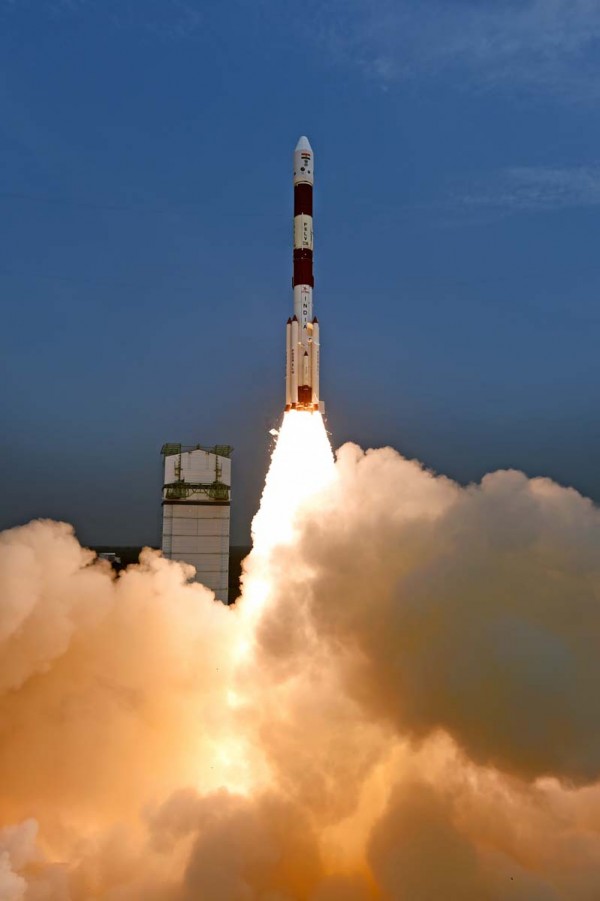India Launched Its First-Ever Space Observatory Satellite
| Vlad Tverdohleb | | Sep 28, 2015 04:17 PM EDT |
(Photo : http://spaceflightnow.com/2015/09/28/indias-first-astronomy-satellite-launched-into-space/)
At 10:00 a.m., Polar Satellite Launch Vehicle (PSLV-C30) successfully launched India's multi-wavelength space observatory Astrosat, along with six foreign customer satellites into orbit.
The observatory was launched from Sriharikota in the state of Andhra Pradesh, said the Indian Space and Research Organization, or ISRO. Astrosat will attempt an intense study of the universe, especially star systems. The launched of the Astrosat indicates another step forward for India's growing space program.
Like Us on Facebook
According to India's junior science minister, Y.S. Choudhury, the launched of the observatory was part of Prime Minister Narendra Modi's vision for India's space program. Modi, who is currently in the United States for his official visit, tweeted his congratulations "Well done @isro, This is one more grand accomplishment for Indian science & our scientists".
The main goal of the observatory is to study the gigantic black hole, which is believed to be existing at the core of the Milky Way. The other purpose of the observatory is to study white dwarfs, distant stars, and pulsars, according to Zee News. The life span of the said mission is 5 years. The Astrosat will send its data to a control center which is located in the city of Bangalore. The scientific payload has a mass of 750 kg and contains six instruments, four X-ray payloads, one ultraviolet telescope, and a charge particle monitor.
Astosat's ultraviolet imaging telescope will scan the sky in visible ultraviolet and far ultraviolet light, focusing on infant solar system closer to home and star-forming clouds throughout the universe. The charge- coupled device camera for Astrosat soft X-ray telescope was provided by the University of Leicester, while detectors for Astrosat's twin ultraviolet and visible imaging telescopes are courtesy of Canadian scientists.
Astrosat took more than 10 years to develop, and scientists are really looking forward for the satellite to work.
©2015 Chinatopix All rights reserved. Do not reproduce without permission
EDITOR'S PICKS
-

Did the Trump administration just announce plans for a trade war with ‘hostile’ China and Russia?
-

US Senate passes Taiwan travel bill slammed by China
-

As Yan Sihong’s family grieves, here are other Chinese students who went missing abroad. Some have never been found
-

Beijing blasts Western critics who ‘smear China’ with the term sharp power
-

China Envoy Seeks to Defuse Tensions With U.S. as a Trade War Brews
-

Singapore's Deputy PM Provides Bitcoin Vote of Confidence Amid China's Blanket Bans
-

China warns investors over risks in overseas virtual currency trading
-

Chinese government most trustworthy: survey
-

Kashima Antlers On Course For Back-To-Back Titles
MOST POPULAR
LATEST NEWS
Zhou Yongkang: China's Former Security Chief Sentenced to Life in Prison

China's former Chief of the Ministry of Public Security, Zhou Yongkang, has been given a life sentence after he was found guilty of abusing his office, bribery and deliberately ... Full Article
TRENDING STORY

China Pork Prices Expected to Stabilize As The Supplies Recover

Elephone P9000 Smartphone is now on Sale on Amazon India

There's a Big Chance Cliffhangers Won't Still Be Resolved When Grey's Anatomy Season 13 Returns

Supreme Court Ruled on Samsung vs Apple Dispute for Patent Infringement

Microsoft Surface Pro 5 Rumors and Release Date: What is the Latest?












